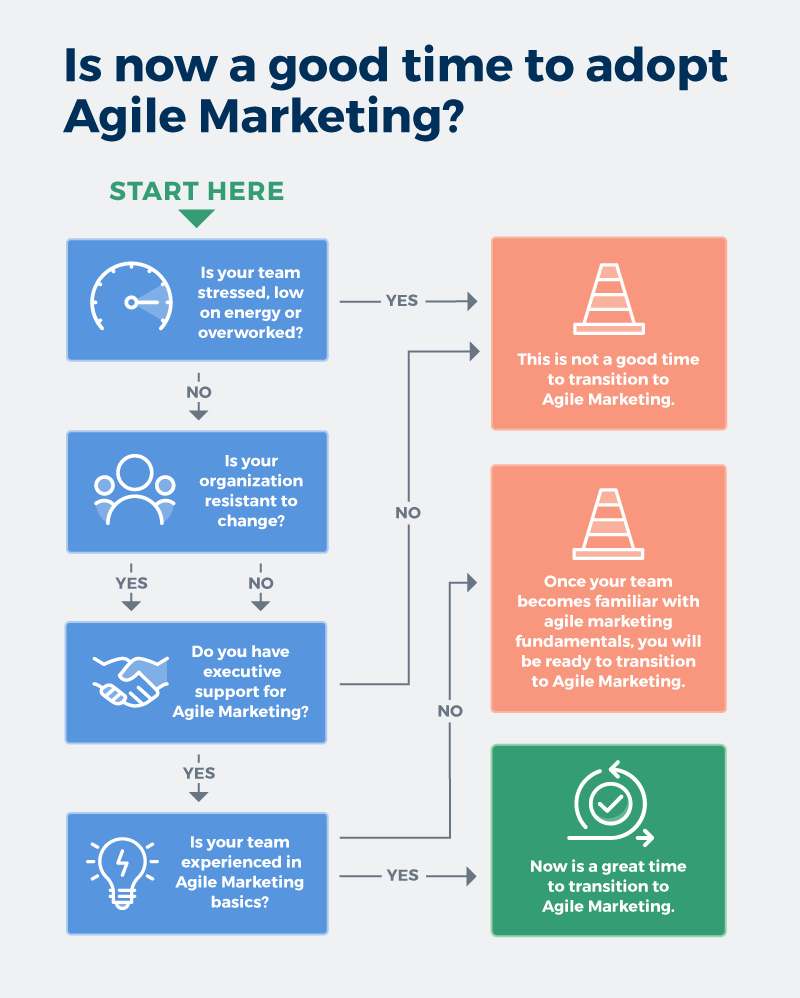What Is Agile Marketing?
Agile marketing is an organizational approach that focuses on teamwork and flexibility, with the goal of increasing marketing efficiency. When implemented successfully, this approach yields high-quality, quick-to-market campaigns.
The speed and collaboration of Agile marketing can benefit your most valuable projects, such as those that bring campaigns to market. Once you complete a project, measure its successes and failures and apply what you’ve learned toward future projects.
The key elements of Agile marketing include adaptation, frequent iteration (especially over the course of major campaigns), and incorporating consumer feedback.
What Is Agile Digital Marketing?
Companies may also consider adopting Agile digital marketing, or Agile online marketing, which follows the same approach as Agile marketing but with an emphasis on digital communication.
Agile digital marketing focuses on connecting with customers who are using the internet, whether via email, social media, text, or chat platforms. Agile digital marketing agencies apply the Agile methodology to their everyday digital marketing efforts.
What Is Agile Project Management Marketing?
Agile project management marketing is an iterative and flexible approach to project management in marketing. Agile breaks down a large project into smaller pieces or iterations, which helps to promote project evolution through group effort and incremental completion.
How Does Agile Marketing Work?
Scrum, Kanban, and Scrumban are frameworks that guide Agile development, and therefore, that apply to Agile marketing. These methods help your team collaborate, track progress, and remain flexible.
Scrumban is a hybrid of Scrum and Kanban, and focuses on teaching flexibility in order to maintain a steady and predictable workflow without becoming mundane.
A key element of Agile methodology is the sprint, which breaks down a larger project into more manageable pieces. The activities you focus on during each sprint come from a backlog of projects. Each sprint also includes a daily stand-up meeting, which allows your team to share current progress and any impediments to completion.
You can use various progress tracking tools to manage backlogs and sprint progress. A Kanban board is one example of a visual representation of task priority and movement to completion. Kanban boards usually consist of three columns: to-do, in progress, and complete.
The History of Agile Marketing
The concept of Agile began in software development as an alternative to traditional Waterfall development. The value of Agile became notable across business departments, particularly those that benefited from project management.
In 2012, a group of marketing thought leaders held SprintZero to develop the Agile Marketing Manifesto. Since then, Agile marketing momentum has found its way into organizations of all sizes.
What Is the Agile Marketing Manifesto?
The Agile Marketing Manifesto is a detailed list of guiding principles for marketing teams. The manifesto contains seven values and 10 principles that help form the foundation of Agile marketing strategies.
Examples of Agile Marketing
Both large and small companies rely on Agile marketing to take their campaigns to market. Read our article on Agile marketing examples to find success stories from real companies.
How to Implement Agile Marketing
Making the transition to Agile marketing can be a major undertaking. The process includes six necessary steps that begin with shifting your team’s mindset from traditional marketing to Agile, gaining leadership buy-in, and equipping the team with processes and the appropriate tools. Additionally, ensure that you have a plan, roles and the right people on board to guide the process.
Below are the six necessary steps for implementing Agile marketing:
- Shift Your Mindset to Understand and Embrace the Agile Marketing Methodology: One of the most challenging obstacles to Agile marketing is the shift away from a traditional marketing style. In some cases, you may need to replace team members who do not adapt to Agile.
- Put the Right People in the Right Roles: Getting the right people in the right positions is fundamental to any initiative. Build a small but talented team that understands the Agile methodology, and make sure you assign each member to a role that matches their skillset.
- Gain Leadership Buy-In: As with any business operations change, a transition to Agile marketing requires executive sponsorship.
- Propagate Expectations Beyond Marketing: It is necessary to set proper expectations for the marketing team, supporting teams, impacted teams, leadership, and stakeholders. The move to Agile marketing relies on support from across the organization. To ensure that all business units fully understand expectations, many Agile teams define service-level agreements with the departments they depend on for services, such as legal contract review or procurement.
- Define Processes: Agile marketing requires new ways of working, such as having daily stand-up meetings and going to market more quickly. These innovations require new, flexible processes that allow for quick turnaround and the ability to pivot when necessary.
- Equip the Team with the Right Tools and Technology: In some cases, a simple whiteboard that acts as a Kanban board satisfies the needs of an Agile marketing team. Evaluate tools based on your needs for backlog and Agile project management.
Agile Marketing Practices
Traditional marketing adheres to firm deadlines and a strict routine, while Agile marketing encourages change. Agile marketing practices aim to improve results through shorter sprints, which you continually measure, seek feedback on, and ideally, improve upon.
Below are the seven values of the Agile Marketing Manifesto:
- Validated Learning over Opinions and Conventions: Validated learning is the idea of studying, implementing, and measuring the results and then applying the new information to improve.
- Customer-Focused Collaboration: Maintaining focus on the customer is a central tenet of Agile marketing. Focus on customer needs, and avoid isolated or groupthink decisions.
- Adaptive and Iterative Campaigns: Begin with small campaigns and measure the results. Doing so will allow you to improve on successful activities and abandon failures.
- Customer Discovery over Static Predictions: Marketing plans that adhere to static predictions often fail because people's wants and needs are unpredictable. By contrast, teams that develop Agile marketing plans focus on making decisions based on real customer engagement and feedback.
- Flexible over Rigid Planning: When it comes to the unexpected (but inevitable) challenges, a strict plan requires rework before moving forward with a project, whereas a more flexible plan can simply adapt to changes — or even benefit from them.
- Response to Change over the Following of a Plan: Flexibility is at the core of Agile marketing. Teams need to remain adaptable enough to change, rather than blindly follow a plan.
- Small Experiments over Large Bets: Investing all of your resources in one project would be catastrophic if said project flops. Instead, spread resources over several smaller projects so that, in the case of failure, you have more minor damage.
What Does An Agile Marketing Team Look Like?
When building an Agile marketing team, ensure that members understand the basics. The foundation of Agile marketing is adaptability, so training a team to work with change instead of against it is the key.
Your Agile marketing team should consist of five or six people, including the following three prominent roles:
- Product Owner and Marketing Leader: Agile marketing teams assign these roles to one person. This person's job is to make all critical business decisions and decide which projects to take.
- Scrum Master: A Scrum master's job is to keep the team on track, facilitate meetings, remove distractions, and ensure that everyone understands what their role is as well as what tasks they should complete.
- Implementer: The implementer's job is arguably the most important. They must prioritize and complete task assignments quickly and resourcefully.
It is also important to assemble a cross-functional team (one that offers a wide variety of expertise). You may consider implementing a war room tactic, which allows the entire team to gather in an area without interruption to discuss the project, solve problems, and coordinate efforts.
Stacey Ackerman, ICAgile Instructor, Certified Scrum Professional, and Founder of Agilify Coaching & Training, outlines Agile roles when applied to marketing. “Scrum has three roles — a product owner, a Scrum master, and developers. The Scrum master and product owner roles are sometimes combined and called a marketing owner in Agile marketing teams that aren't strictly following the Scrum framework. This role has many responsibilities, such as prioritizing work for the team and helping the organization adopt Agile.
“Ideally, there's no hierarchy in Agile marketing teams,” Ackerman continues. “HR-assigned job titles may still exist, but within an Agile team, all members are considered equals. Leaders in Agile marketing don't assign work; the team determines how much work it can accomplish by choosing items from a prioritized backlog. Agile marketing is about the mindset of working as a self-organizing, empowered team in order to deliver value to customers more quickly. Processes and tools are secondary.”
The Downside of Agile Marketing
The downside of Agile marketing is that to employ it, you must disassemble previous strategies. Doing this makes room for a new, less rigid way of thinking, which may make people uneasy at first.
Here are some other reasons that people may not accept Agile marketing:
- New and Unknown Concepts for the Team to Learn: Many groups simply do not have the time to teach employees new methods. (This fact applies in particular to fast-moving, busy teams.) In addition, the new and unknown can be intimidating.
- The Lack of a Need to Change: Sometimes, things are best left as they are, and there is nothing wrong with this philosophy, as long as such things are practical.
- An Unwillingness to Overcome Business as Usual: It can be challenging to adapt to the Agile marketing workflow, especially if an organization has been practicing a different style for a long time.
When Not to Transition to Agile Marketing
While there are many benefits to Agile marketing, the method isn’t necessarily suitable for everyone. In some cases, it may even delay progress on established processes.
If your team is already overworked, stressed, and running low on energy, taking on a new marketing strategy may not be a good idea. Similarly, not all employees thrive in an Agile environment, a reality which can lead to lower productivity. Before taking on Agile marketing, it is essential to note whether your team is willing to change.
The Agile marketing adoption decision tree below will walk you through a set of questions to help you determine if Agile marketing is a good option for your team
Why Adopting Agile Marketing May Be Beneficial
Agile marketing allows you to use change to your advantage. Tailoring each project to the changing markets, merging impactful requests, and gaining an advantage over competitors that use a one-size-fits-all strategy are just a few benefits of Agile.
Additional Agile marketing benefits include the following:
- Respond to Marketing Changes: By working with flexible (rather than rigid) teams, you can meet marketing changes.
- Optimize Campaigns: By working with several smaller campaigns rather than with one universal campaign, you have more room to personalize, update, and improve according to changing needs.
- Demonstrate Value More Quickly: Another critical tenet of Agile marketing is constantly looking at data from past projects in order to repeat the processes that lead to success.
- Increase Team Focus and Collaboration: By encouraging a more open and adaptable environment, teams focus on the task at hand and work more closely together.
- Increase ROI: With Agile marketing, teams can respond more quickly to consumer feedback and produce higher-quality campaigns. Having this ability results in greater long-term financial reward.
- Quickly Scale: Agile marketing offers the ability to use data in order to fine-tune quality, your team's impact, and the budget put toward a particular project. As a result, you can easily scale the strategy to suit a project of any scope.
The Challenges of Agile Marketing
As with any other business strategy, Agile marketing offers its own slew of challenges and setbacks. And though the method is often worth the effort, it remains difficult to gain executive buy-in, restructure teams, and make other changes.
Here are some examples of challenges you may face:
- Garnering Executive Buy-In: Agile marketing may require you to convince executives of its effectiveness. This may mean presenting a plan with success criteria, especially if additional funding is necessary to implement Agile marketing.
- Restructuring Teams: Restructuring your team takes time and patience, especially when the concept is unfamiliar.
- Changing Mindsets: Sometimes, when a company operates under specific rules and practices for long periods, it can be hard to break old habits and adopt a new way of thinking.
- Keeping Team Members in Sync: One of the key components of Agile marketing is teamwork. If team members cannot keep the same pace, communicate, or do their part, the initiative will likely crumble.
How to Measure Agile Marketing Success
Effectively monitoring success with Agile relies on knowing which metrics to track — namely, you should look at the speed of task completion per sprint and compare it to previous strategies.
Here are some additional Agile marketing metrics that Agile marketers recommend tracking:
- Throughput: “Agile marketers have different opinions on the order in which you should focus on the big three metrics — cycle time, throughput, and efficiency — but we judge success, first and foremost, based on throughput,” says Bryce Welker, CEO of CPA Exam Guy. “Throughput is a measurement of how many tasks a team completes in a given amount of time, and it is useful because it is a function of both of the other measures. If you are scoring high on task efficiency and your cycle time is low (which is of course what you want), then your throughput is going to be higher.”
- Cycle Time: “Our number one Agile marketing metric is cycle time, which is the time it takes to finish a specific task,” says Petra Odak, CMO at Better Proposals. “We have processes set up to easily measure how much time it takes to wrap up a task. Suppose [the time it takes] increases over time, but the difficulty of the task remains the same. In that case, it means that something is wrong with the way we communicate, who we assign tasks to (i.e., the wrong people), or something else. This is a great productivity metric that keeps us from working on the same tasks for weeks at a time.”
- Cost: By and large, the most motivating reason behind adopting a new strategy is to save money in the long term. When measuring the success of your Agile marketing strategy, consider the following: How much more cost effective is this strategy compared to past methods and project management strategies? You do not have to look far to collect data for this point. Simply compare your pre-Agile marketing costs to your post-Agile marketing costs, aka current costs.
- Tangibility: One thing that many teams fear about Agile marketing is that it is based on abstractions rather than on cold, hard data. If you are employing Agile marketing skillfully, however, this should not be the case. When considering the success of your Agile marketing efforts, ask your team to break down each project and describe why each task belongs. If they can do this, then it is a sign that Agile marketing may be working.
Myths about Agile Marketing
There are several myths surrounding Agile marketing, and many of them make the method sound undesirable and unprofessional. The following myths may discourage establishments from trying it:
- Agile Marketing Is Disorganized: Many people say that Agile marketing throws all planning out the window and that teams work without direction. The truth is that Agile marketing plans are less fixed, which makes it possible to adapt when other methodologies cannot.
- Quality Suffers with Agile Marketing: While many people think Agile marketing teams disregard quality to produce expedient results, this is not the case. Agile team members seek quality data faster than other marketing teams.
- Agile Marketing Only Makes Sense for Small Businesses: Some larger companies refuse to attempt Agile marketing because they think the model is only suitable for smaller businesses. While it may be more of a difficult transition with a larger team, it is certainly doable.
- Agile Marketing Promotes an Unmotivated Work Environment: Lastly, when many people picture Agile marketing, they picture chaos and people lazing around, doing whatever they want. Brightly colored offices that offer free food and toys (and sometimes even allow pets to roam around) are not uncommon media depictions of the Agile work style. On the contrary, Agile is just as structured as most other strategies, if not more so.
The Agile marketing workforce is constantly growing. With more Agile marketing training courses and more companies adopting the methodology, experienced Agile marketers are not hard to come by. Of course, Agile marketing is not for everybody — success depends on the people involved and the company's ability to adapt to change. If employees are unable or unwilling to change their methods, the production rate is likely to fall.
Accelerate Your Campaign Management with Agile Marketing from Smartsheet
The best marketing teams know the importance of effective campaign management, consistent creative operations, and powerful event logistics -- and Smartsheet helps you deliver on all three so you can be more effective and achieve more. The Smartsheet platform makes it easy to plan, capture, manage, and report on work from anywhere, helping your team be more effective and get more done. Report on key metrics and get real-time visibility into work as it happens with roll-up reports, dashboards, and automated workflows built to keep your team connected and informed. When teams have clarity into the work getting done, there’s no telling how much more they can accomplish in the same amount of time. Try Smartsheet for free, today.



